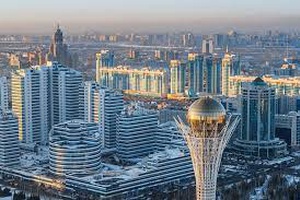Kazakhstan, the imperative to cooperate edit

Landlocked in the heart of Central Asia, Kazakhstan is involved in regional partnerships and, pragmatic, claims to be a facilitator with balanced relations, even if the pressure to take a stand between Russia, China and the European Union is strong. This cocktail is the challenge of so-called middle power (or bridge) countries, developing multi-factor diplomacy, here constrained by geography and made possible by the country’s resources. Moreover, the development and identity of the five Central Asian countries are built around the imperative of cooperation, given the geographical position and the small number of citizens (75 million for the five countries).
The 2023 edition of the Astana Forum, formerly economic and renamed Astana International Forum, was structured around four themes: foreign policy and international security, international development and sustainability, energy and climate change and economy and finance. This forum supports the development of international action: dialogue of international themes, with the desire to propose answers, desires to become a reference on the world scene without forgetting a public relations dimension. This has resulted in Kazakhstan’s diplomacy being described as ‘niche diplomacy’ (for uranium exchanges) or multi-vector diplomacy[1].
Since February 2022, the Belt and Road Initiative, China’s connectivity project, no longer pass through Russia. Kazakhstan is at the centre of the EU-funded Asia-Europe Transport Road (or Trans International Transport Road). This is one example where the economy, originally considered by Joseph Nye as a resource of hard power, becomes a factor of attractiveness and image for a country. In terms of analysis, considering a continuum – not a strict dichotomy – between hard power and soft power allows for more flexibility between projects and resources.
This multilateral institutional program connects the rail freight container transport networks of China and the EU. The multimodal transport structure connects the Caspian and Black Sea ferry terminals with the rail systems of Asian and European countries. The route starts from Southeast Asia and China, crosses Kazakhstan, the Caspian Sea, Azerbaijan, Georgia, and Turkey.
The so-called middle corridor is present in the speeches and in the initiatives and funding of the European Union and China. This land logistics link between the China and EU trading zones goes beyond transport to digitation of data and complying with European Union and UN standards. Therefore, several models are facing together depending on the view of China or the Union.
Beyond this situation, what are the challenges for this middle power and in the broader context of countries that voluntarily and reasoned choose an identical approach and positioning?
A successful solution for a middle power means choosing specific negotiating topics in the international space, being agile and flexible, and knowing how to build coalitions to defend them. In the context of multilateralism, it is necessary to structure actions for a convergence between its interests and those of the partners rather than on an ideology. This is one of the conditions for becoming credible, for developing its discourse and, ultimately, to be perceived by the international community as a country with positive contributions. And beyond this community, by the public, which comes down to finding its place on the world map in the long term, when the country becomes known and better identified. Diplomacy becomes public, because it consists of informing, or even dialogue with public opinion.
Thus, the Astana Forum presents a middle power capable of building a regional dialogue with experts, politicians, and international actors, which contributes to the construction of legitimacy and the ability to influence through contacts, cooperation and media coverage.
Being a middle power also means being courted in alliance competitions whose number and formats become exponential, which generates as many acronyms as possible, here China + C5 and EU + C5.
Two recent summits, beyond content and photos, tell the stakes. The China-five Central Asian summit took place in May 2023 in Xi’an, China with the signing of 54 multilateral agreements.
The meeting of the European Union and the five Central Asian countries took place at the beginning of June in Cholpon Ata, Kyrgyzstan. These are the five countries being courted no doubt with strong pressure to choose one or the other alliance, hence the tensions and questions of cooperation already mentioned.
Moreover, contradictions exist between the possibilities and wills of the middle powers and the driving force of international institutions, structures with more rigid rules, including, for example, the Security Council.
A new paradigm is emerging: the role of coalitions. Finally, middle-power countries must balance their national interests, common international challenges such as climate change, and building alliances and coalitions. Claims of middle powers, alliances and coalitions and connectivity programs may be shaping the geopolitics of tomorrow.
Vous avez apprécié cet article ?
Soutenez Telos en faisant un don.
(et bénéficiez d'une réduction d'impôts de 66%)
[1] Pantucci, Raffaello, et Alexandros Petersen. 2022. Sinostan: China’s Inadvertent Empire. Oxford University Press.

